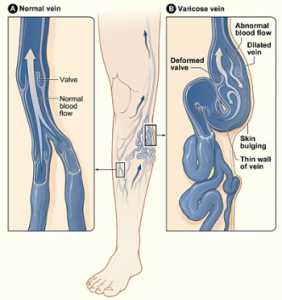Vein Ablation – Varicose Veins Treatment
What are varicose veins?
Varicose veins are enlarged veins which are close to the skin’s surface. They are usually visible and can become painful particularly after prolonged standing or walking. Most commonly affected veins are those in the legs and feet due to the increased pressure, which affect valves in the veins, resulting in retrograde (downward) flow of the blood.
Downward direction of the blood flow (which is increased by the gravity) further damages valves, which fail to close properly, allowing pooling of the blood and stretching and thickening of the affected veins.
What are the symptoms of varicose veins?

Diagram of a normal vein vs a varicose vein
Symptoms vary depending on the severity of the problem and may include aching legs, ankle swelling, redness, dryness, itchiness of the affected area, cramps, skin discolouration, restless leg syndrome etc.
Conservative treatment includes regular rest in elevated position combined with gentle exercise, elastic stockings to support the weakened veins.
Note:
- The illustration shows how a varicose vein forms in a leg.
- Figure A shows a normal vein with a working valve and normal blood flow.
- Figure B shows a varicose vein with a deformed valve, abnormal blood flow, and thin, stretched walls. The middle image shows where varicose veins might appear in a leg.
Radiofrequency and laser vein ablation
Radiofrequency vein ablation is minimally invasive interventional procedure that uses radiofrequency or laser to seal off varicose veins. Using ultrasound guidance a thin catheter is inserted through the skin into the vein (great saphenous vein).
When properly positioned, radiofrequency or laser energy is applied, heating up the vein and closing it off. Once the varicose vein is closed, other healthy veins will take over the function of that vein and establish normal blood flow.
Do you offer another option for varicose veins besides vein ablation?
Yes! Sclerotherapy is also an option for varicose veins. Lean more about sclerotherapy here.
Do you have a FAQ page for varicose veins?
Yes! Your varicose veins questions are answered here.
Author: Dr John Vrazas
